The Best Vegan Protein Sources (And How To Cook With Them!)
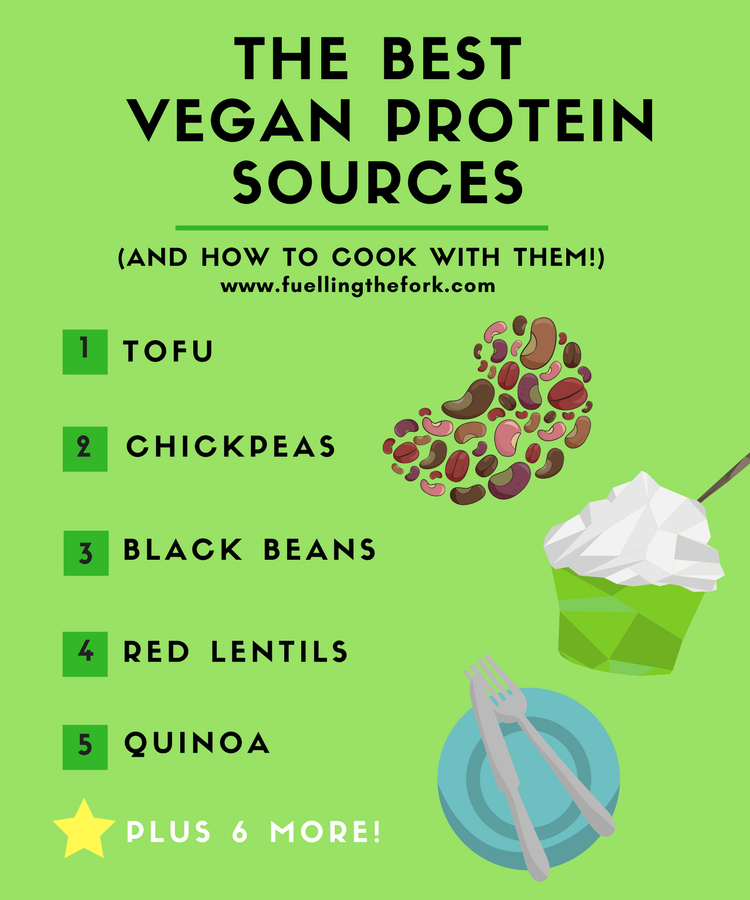
Hi all! Coming at you with something a little different today- the BEST vegan protein sources!
I often receive questions from family and friends asking me which foods they should be eating as part of a healthy diet. As a result of scaremongering from the media, hype over the newest diet trends and just general misinformation, there now exists so much confusion about what foods we should actually be consuming to support optimal health. This can leave us feeling completely lost and unsure of where to start when it comes to eating a healthy diet.
THE PROBLEM
The vegan, -or plant based- diet has amassed a lot of praise for its various health benefits over the years. In the media particularly, veganism can often be portrayed as a virtuously healthy, ‘clean’ diet full of fruits, vegetables, whole grains, nuts and seeds- not an ounce of processed food in sight. And I can’t deny that there is a growing number of vegans who do eat this way, which is not at all negative. But we must remember that the individuals behind the beautiful social media accounts full of vegan smoothie bowls, colourful salads and avocado on toast only represent a small subset of the population.
I have met many a vegan whose intentions are pure; they want to spare the environment from the negative impact of meat production and/or they care too much for animals to justify the eating of them. Unfortunately, many simply cut out the meat and dairy but continue to base their diet upon processed breads, pasta, chocolates, sugary desserts and more- just so long as it is free from animal products, or accompanied by the label ‘vegan’.
The KEY thing to remember is that just as a food labelled ‘gluten free’ does not guarantee any improved health benefits, a food labelled ‘vegan’ does not necessarily equal a positive ingredient list.
Another potential reason for unhealthy dietary choices can simply be due to a lack of protein- the effects of which can amp up those carbohydrate and sugar cravings even more. Protein is hugely important for our body- it aids in muscle repair, speeds up chemical reactions and plays a role in cell signalling. But one of the functions that we can feel the immediate benefit of is the satiety it brings. In other words, it keeps us feeling full!
SO, WHAT’S THE PLAN?
First, aim to eat a diet primarily made up of whole, unprocessed ingredients. If we know the ingredients that are naturally vegan, we won’t need to go looking for sugary substitutes for our old favourites. Second, try to get in a source of protein with every meal.
Also worth mentioning: just because you can’t pronounce an ingredient, this doesn’t necessarily mean that it is bad. If you do come across a product with a list full of ingredients you don’t recognise, why not look them up? It could be something as simple as the chemical name for a vitamin eg. phylloquinone is actually the name for vitamin K1!
What I hope to do is provide you with a simple list of cheap, healthy, vegan protein sources we can easily incorporate into the diet without having to source special ingredients from outer Mongolia or spend a months rent on the grocery bill. Are you on board? Okay, let’s get to it!
Tofu
What is it?
Tofu, also known as bean curd, is an unfermented soy protein produced from the curd of coagulated soy milk. It is then pressed into a solid block and cooled. Tofu is available in many different forms, from silken tofu right up to extra firm tofu. Silken tofu falls apart very easily, whereas firmer tofu has a spongier texture. The composition of the tofu will determine how you prepare it. For more info on tofu varieties, this is a great article.
How do I cook it?
Tofu can be pan fried, stir fried, baked, simmered in soups, or eaten as is!
What can I make with it?
Silken tofu is great in desserts, as its smooth texture means it can easily be combined into sauces or spreads. Since it falls apart very easily, silken tofu can also work really well when combined with herbs and spices to make vegan scrambled eggs. Firmer types of tofu are delicious cut up into cubes and stir fried with some vegetables, or added into your favourite curry recipe. Tofu naturally has a very bland flavour, so it takes on other flavours extremely well.
Here are some great recipes to get started:
1. Thai Red Coconut Curry with Courgetti
2. Spicy Tofu Scramble
3. Vegan Dark Chocolate Tofu Cheesecake
Tempeh
What is it?
Tempeh is a minimally processed soy based vegan protein source. It is made from whole soy beans which are cultured and fermented to create a cake like texture.
How do I cook it?
Much like tofu, tempeh can be pan fried, stir fried, baked, or used in soups, stews and burgers.
What can I make with it?
Tempeh is really versatile, and has one of the closest consistencies to meat when compared to other common meat alternatives. Why not try using tempeh in a stir fry or simply seasoned, cut into strips, pan fried and served with your favourite veggies? You could even try tempeh tacos!
Here are some great recipes to get started:
1. Black Bean Tempeh Tacos
2. Sesame Garlic Noodles with Broccoli, Basil and Cripsy Tempeh
3. Spicy Black Bean Soup
Chickpeas
What are they?
Chickpeas, also known as garbanzo beans in the US, are a legume with a nutty taste and a texture similar to a hard truffle. Popular in Indian, Middle Eastern, Mediterranean and North African cuisine, chickpeas have a low GI (glycemic index) and are full of both soluble and insoluble fibre. They are available year round and can be found dried and packaged, or tinned. If buying tinned chickpeas, strive for both organic and BPA free tins, as many contain a plastic lining.
How do I cook them?
If buying dried and packaged chickpeas, you will need to soak them in some cold water overnight (or for at least 1 hour) then drain and rinse them. Next you’ll need to add them into a pan of water. Bring this to the boil, then turn down to a simmer and leave for 60-90 minutes depending on how tender you’d like them. Here’s a great tutorial. If buying canned chickpeas, you don’t need to do anything- these are already cooked and good to be used in whatever dish you’re making as soon as you open them!
What can I make with them?
Chickpeas are a hugely versatile vegan protein source. One of their most obvious uses is for hummus or falafel, but they can also be used in shakshuka, a North African dish that uses tomato sauce as a base for cooking eggs. Chickpeas are also delicious in salads, curries and even healthy blondies!
Here are some great recipes to get started:
1. Vegan Chickpea Curry
2. Healthy Vegan Falafel
3. Peanut Butter and Chocolate Chickpea Cookie Bars
Butter Beans
What are they?
Butter Beans, also known as lima beans, are a beige coloured legume with a soft, floury texture. They are a highly nutritious food with a great vitamin and mineral profile, but they are high in soluble fibre, potassium and folates in particular. They are available year round and can be found dried and packaged, or tinned. If buying tinned butter beans, strive for organic beans and BPA free tins, as many contain a plastic lining.
How do I cook with them?
If buying dried butter beans, you will need to soak them before cooking on a simmer. Check out more detailed instructions here. If buying canned butter beans, you don’t need to do anything- these are already cooked and are good to be used in whatever dish you’re making as soon as you open them!
What can I make with them?
Butterbeans are a popular ingredient in soups, stews and salads.
Here are some great recipes to get started:
1. Sweet Potato, Spinach and Butterbean Stew
2. Butterbean and Courgetti Salad
3. Pesto Butter Bean Salad
Black Beans
What are they?
Black beans are a shiny black bean that possess quite a rich, earthy taste. They are especially popular in Latin American cuisine and are extremely low fat and high in folate, copper and thiamine. Black beans are most commonly found dried and packaged, but they can also be purchased tinned. If buying tinned black beans, strive for organic beans and BPA free tins, as many contain a plastic lining.
How do I cook them?
If using dried black beans, many people report that soaking them before cooking can remove a lot of their flavour. With this in mind, simply rinse your beans before adding them into a large pot of water, bringing it to the boil then simmering for 1-2 hours.
What can I make with them?
Black beans work very well with grains, in particular rice. Mixing beans and rice at a meal makes for a great vegan protein source, as the two ingredients combined contain all of the essential amino acids. Black beans are also commonly used in soups, stews and burgers.
Here are some great recipes to get started:
1. Lazy Cooks Black Beans
2. Super Quick Vegan Black Bean Burgers
3. Plantain and Black Bean Tacos with Chimmichurri Sauce
Kidney Beans
What are they?
Another fibre rich legume, kidney beans are shaped like a cashew, have a soft texture, distinctive flavour, and can be red or white in variety. The red kidney bean is the most common. To name a few of their benefits, kidney beans are a great source of molybdenum, folate and copper. They are available year round and can be found dried and packaged, or tinned. If buying tinned kidney beans, strive for organic beans and BPA free tins, as many contain a plastic lining.
How do I cook them?
Important: Kidney beans are a fantastic vegan protein source, however, there is one thing to be mindful of. Raw kidney beans contain a particularly large amount of a lectin called phytohemagglutinin. This lectin binds to the membranes of T-cells in the body and interferes with cellular metabolism when consumed in sufficiently large quantities (SOURCE). However, soaking and then cooking the kidney beans at high temperatures significantly reduce their phytohemagglutinin content to what should be a safe amount for us to consume. Use BPA free, tinned, organic kidney beans that have already been cooked if you’re concerned about this. Otherwise, if using raw kidney beans, be sure to soak them overnight then boil them either on the stovetop or in a pressure cooker until cooked. If using a slow cooker, it’s vital to pre-boil the kidney beans as the low temperature in a slow cooker is not sufficient to destroy the high levels of phytohemagglutinin.
What can I make with them?
Kidney beans are most popular in the delicious Chili Con Carne dish. Outside of this, they are also great in soups, stews and salads. They can even be used in sweet treats as they lend a deliciously fudgy texture!
Here are some great recipes to get started:
1. Bulgur Vegetarian Chili
2. Quinoa and Bean Chopped Salad
3. Vegan Chocolate Hazelnut Donuts
Red Lentils
What are they?
Red lentils are a pulse belonging to the lentil family (no way!). Compared to other lentil varieties, red lentils are by far the quickest to cook. They are actually closer to orange in colour, and are usually found dried and packaged. They are cheap and can be found in any supermarket. Popular in India and other Asian countries, red lentils are high in soluble fibre, folate and vitamin B1.
How do I cook them?
Simply rinse the red lentils before adding into a pan with some water or vegetable broth. Feel free to add spices. Bring to the boil, then simmer for about 15 minutes if you’d like them to retain a bit of crunch, or leave them to cook for up to 25 minutes if you’d like them to be a more mushy consistency, for instance if you were adding them into a curry or soup.
What can I make with them?
Lentils are notoriously delicious in soups, stews and curries.
Here are some great recipes to get started:
1. Healing Turmeric and Red Lentil Dahl
2. Aubergine and Red Lentil Curry
3. Lemony Lentil and Crispy Kale Soup
Yellow Split Peas
What are they?
Split peas are a type of field pea, which means it is a pea grown specifically for drying before being hulled and split in half along its seam. They have the savoury element of a bean with the subtly sweet edge of a pea and are a great source of fibre, molybdenum and manganese. They are naturally very low fat.
How do I cook them?
Wash the split peas before bringing them to the boil, then a simmer, for about 30 minutes. You can cook them in plain water, broth or herbs and spices, or even within a pre-made sauce. They will soak up a lot of liquid as they cook, so you may need to add in more water as you go along.
What can I make with them?
Yellow split peas are the perfect addition to soups, stews and curries.
Here are some great recipes to get started:
1. Greek Fava
2. The Best Detox Crockpot Lentil Soup
3. Cauliflower and Yellow Split Pea Soup
Quinoa
What is it?
Quinoa is an ancient ‘grain’, which is actually a seed that is eaten as a grain. It has a mild, nutty flavour. Quinoa has become a bit of a superfood in recent years, and for good reason- it is gluten free, high in protein and one of the only plant foods to contain a full essential amino acid profile- yup, all nine of ’em! This makes it a great vegan protein source. It comes in three different varieties: white, red and black and can be found in most big supermarkets and health stores at a mid level price range.
How do I cook it?
Quinoa can be quite a tricky one to cook, but fear not, it can be done. Simply rinse it under cold water, add it to a pan and top with boiling water or stock. Boil for 15-20 minutes, by which point it should have absorbed all of the liquid and taken on a fluffy appearance.
What can I make with it?
Quinoa can be used for almost anything you could think of, it seems. Try using it as a replacement for rice or pasta, in soups, curries, stews, salads, crackers or even baking.
Here are some great recipes to get started:
1. Slow Cooker Coconut Quinoa Curry
2. Quinoa Superfood Salad
3. Sea Salt and Dark Chocolate Quinoa Energy Balls
Soy Yogurt
What is it?
Soy yogurt is a dairy free yogurt made from soy milk. It has a nutty, creamy flavour and is delicious as a snack or breakfast food. It is high in protein, low in saturated fat and a good source of calcium. Soy yogurt can be found in the chilled aisle next to the dairy yogurt in most major supermarkets and health food stores.
How do I cook it?
The good news is, you don’t have to! Soy yogurt is good to go. My favourite brand is Alpro. Alternatively, for extra healthy points you can try making your own. This recipe looks delicious.
What can I make with it?
Soy yogurt is delicious eaten for breakfast with fruit, nuts, seeds, or granola. It’s also great in smoothies, to make dipping sauces, mixed with protein powder as a protein rich snack or even just as it is.
Here are some great recipes to get started:
1. Vegan Cream Cheese with Cashews
2. Warming Fruit Bowl
3. Granola, Kiwi and Blueberry Breakfast
Protein Powder
What is it?
Vegan protein powders are a quick and easy way to boost your protein content. They are created by extracting the protein component of a food through a variety of methods that may include concentration, isolation, hydrolysation or microfiltration. Some people express concerns that protein powders are unnatural or processed. Vegan protein powders are processed to a certain extent, but only in that they are a byproduct of a whole food. However, always be sure to read the label. A lot of protein powders contain a ton of artificial sweeteners that may somewhat negate its health properties. Protein powders are completely safe to use on a regular basis. For vegans, they are usually, soy, rice, pea or hemp based. One of my favourite companies for vegan protein is Live Innermost.
How do I cook it?
You don’t! Protein powders are most commonly stirred into foods or drinks that have already been cooked, or those that don’t require any cooking at all. Having said that, protein powder can also be used as a replacement for flour to boost the protein content of your bakes! But beware, too much protein powder can somewhat alter the texture of the finished product.
What can I make with it?
Protein powder is commonly used in smoothies and shakes, or mixed into bowls of cooked porridge or a bowl of yogurt. They can also be used for baking things like cookies, muffins and breads.
Here are some great recipes to get started:
1. Mango, Papaya and Raspberry Breakfast Parfait
2. Pina Colada Protein Smoothie bowl
3. Hemp and Goji Berry Raw Protein Bars
And there you have it: Eleven cheap, easy to find ingredients to help you towards your daily vegan protein fix! I hope this helped you out and showed you that a plant based diet doesn’t have to mean turning to junk food- these are all super delicious, nutritious vegan protein sources that can easily fit into huge variety of meals.
What are your thoughts on these vegan protein sources? Did I miss anything out? Let me know in the comments!
Comments
- 6 of The Best Vegan Protein Powders | Fuelling The Fork - […] your plant based protein exclusively from natural sources? Then look no further than my post on the Best Vegan…

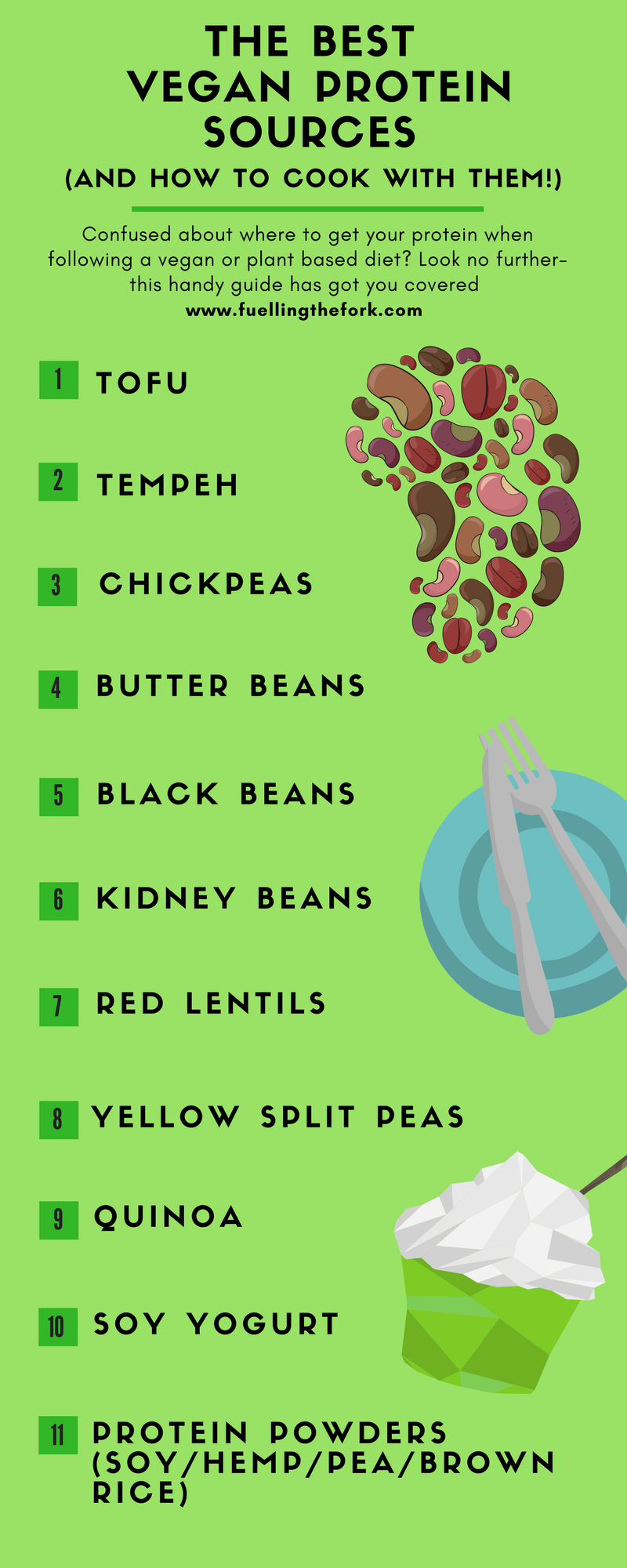



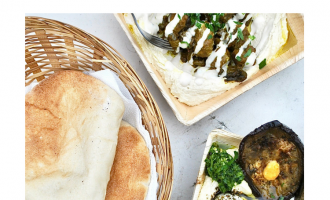
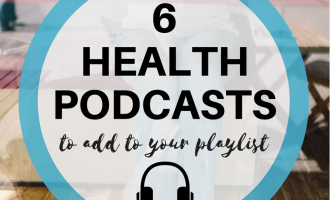
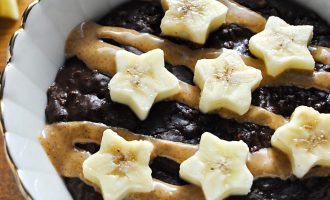
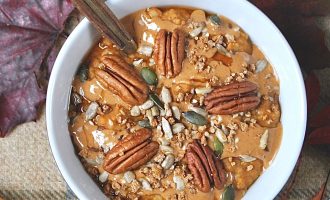
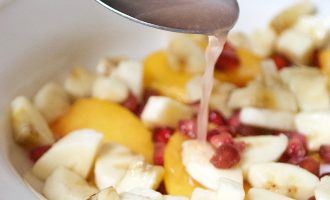
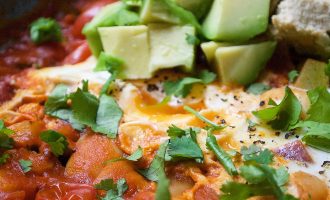
Ashley Woodward
17th October 2017
Really love your post, it has great structure, it’s simple and understandable, and these recipes are amazing! Definitely coming back for more! Also appreciate your aim to make healthy food exciting!
fuellingthefork
18th October 2017
Aww your comment made my day! Thanks so much, Ashley. I’m glad you found this useful!
Paul
26th January 2017
Bookmarked 😀
fuellingthefork
26th January 2017
Woooo thanks- glad you liked it! 😀